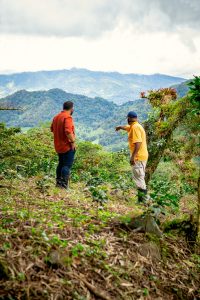HARVEST PROCESS
Coffee pickers have to collect cherries from each plant individually, waiting for a few weeks to let other sections of the farm to mature since we only pick the most intensely “scarlet red cherries”









Picking
Picking is the most effective method yet one of the most expensive ones because it requires lots of hands to pick as most coffee as possible, this process guarantees that the cherries that are used are the best ones. During every harvest the timeline for picking varies as climate conditions can change the period, most of the time pickers start in October and end in March. Indigenous Peoples in the region are skilled in this method and know the land very well, so they are essential to our work in the farm, which in turn contributed to the socioeconomic activity of the region and improves their quality of life as some years, coffee production is so high that they are able to collect vast amounts.
Pulping
The next step consists of detaching coffee from its red covering and jelly-like substance. Previous to this method, coffee is only stored for about 6 hours in a receiver tank filled with water. That same day, the water-pressurized machines pulp the cherries and the beans remain with a transparent film called “pergamino”. The only part of the cherry that is used for coffee processing is the bean inside it, which goes later on to fermentation processes. The pulp in our farm is used as fertilizer for the rest of the plantation.
Drying Process
This process is done in different ways, depending on weather conditions. We use special ovens fueled with deadfall trees or the remainder of the parchment that the beans shed after processed to ensure sustainable production and forest preservation. There are some occasions in which it is dried under the sun and on African beds or “bastidores” that protect processed beans from rainfall; these are open like drawers when the sun is out.
Parchment Elimination / Bean Classification
After pulping, the washed beans remain with a thin membrane called parchment or pergamino, which is removed and used for other purposes before the green beans go through the drying process. After the parchment is removed, beans go through a special machine that classifies them depending on size and shape, we export and sell in the national market as much first class coffee as possible, the rest is still great quality coffee but not as homogeneous as first class/export quality coffee. Before the coffee gets to roasting phase, it rests in wooden silos, away from humidity and outside influences that could modify its taste if not monitored correctly.
Roasting and Storage
After the grain goes through classification process it undergoes one of the most delicate processes in the harvest, roasting. In this part of the process coffee is exposed to temperatures that reach 175 degrees Celsius/ 375 degrees Fahrenheit for approximately 11 minutes, depending on the roasting level that the consumer desires. Café Princesa Janca’s caturra and catuai blend provides a better palate experience when it reaches a medium roast, even a lighter roast gives out floral notes and a perfect acidic balance with rich chocolate-like aroma. After the roasting process takes place it undergoes a cooling period in the roasting machine to reach room temperature.
Once the roasting process is over it is stored in special silos where it rests for some days in order to be packed and shipped to the national market in whole beans or grinded.
